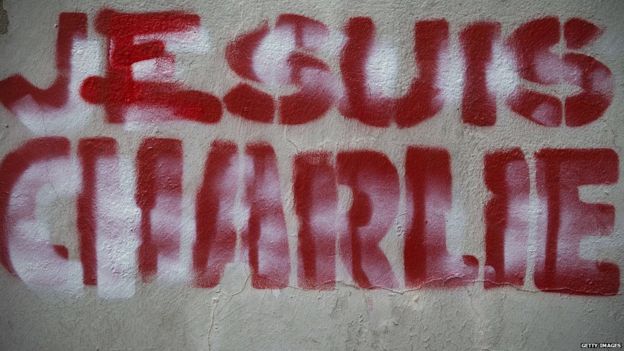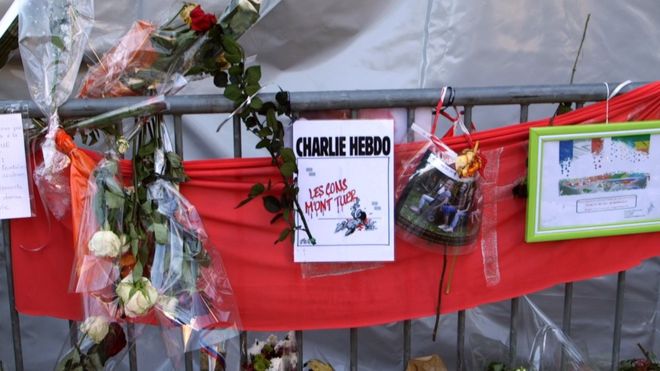A year ago, millions rallied for free speech after the first Paris attacks, by posting "Je Suis Charlie" online. Here`s what happened next.
"We all stopped everything," recalls Joachim Roncin. "Something big was happening."
Roncin was at work as an art director at a magazine on in central Paris on 7 January. Like the rest of France and much of the world, he was following the news as two brothers stormed the offices of Charlie Hebdo magazine - killing 11 of its staff. Five others were killed in a three-day spree of terrorist violence.
"I was deeply shocked, but I wasn`t frightened," Roncin recalls says. Sitting at his desk, he decided to adopt the font of the Charlie Hebdo masthead into a simple black and white image that said "Je Suis Charlie" - "I am Charlie". He posted it on Twitter:

It was "something that I wrote just for me," he says. "I didn`t buy Charlie Hebdo, but it is part of my youth."
His illustration, and the associated slogan, would become perhaps the biggest hashtag of solidarity in history. Not only was it used 1.5 million times that day and around 6 million times over the next week on Twitter, Instagram and Facebook, but copycat "Je Suis" hashtags have sprung up to show solidarity with all manner of causes since.
But the symbolic nature of "Je Suis Charlie" - along with the way the gunmen singled out the magazine - also led to division and, ultimately, placed new pressure on the Charlie Hebdo survivors.
What is Charlie?
Founded as Hara Kiri in 1960, Charlie Hebdo is a radical weekly taking rude swipes at the establishment. Its motto was "bete et mechant" - or "mean and nasty." Its drawings are meant to provoke a reaction. Cartoons of the Prophet Mohammed brought the editor, Charb, death threats, as well as 24-hour police protection - but that did not stop the attacks on 7 January, in which he was killed.

Joachim Roncin`s slogan seemed to express a larger idea, though - that standing with Charlie Hebdo was a statement of values against the terrorists.
Four days after the attack, 4 million people marched on French streets, a demonstration unprecedented since the World War Two. Many held the image Joaquim Roncin had designed, and chanted his words.
The slogan took off because "we`re trying to feel a community," he says. "It is very reassuring to be all together whenever there is something horrible happening."
The survivors at Charlie Hebdo eventually thanked him for his slogan, he says - recalling a meeting with the cartoonist Luz. "He said thank you so much," says Roncin. "It was a relief." But in fact, the fallout from the hashtag was just beginning.

A debate: what does it mean to be Charlie?
The first thing to happen - and quickly - was that many declared they felt alienated by "Je Suis Charlie" because, despite the horrific events, they still disagreed with the magazine`s editorial line. Those cartoons of the Prophet Mohammed for example, didn`t just offend Islamists - they were criticised by many others as racist.
Within just a day of the January attacks, a counter-hashtag peaked - "Je Ne Suis Pas Charlie" or "I am not Charlie" - driven by users from France and the West but also popular in the Middle East, Latin America and Pakistan.
The day after that, another - much bigger - hashtag peaked on Twitter, "Je suis Ahmed," which used the name of a policeman, Ahmed Merabet, who was killed in the attacks and was a practicing Muslim.
"Je Suis Charlie attributed some kind of nobility to the content of the newspaper, which I couldn`t really agree with," says Dyab Abou Jahjah, a Belgian writer who tweeted that tag. "My problem with them is that they publish racial stereotypes of Muslims."
"Of course it`s their right," he adds. "But it`s the right of people to be appalled by it as well."
When millions are Charlie - what does Charlie become?
Looking back on the hashtag`s effects a year on - and after a second, even larger, massacre in Paris - one key question is how it impacted Charlie Hebdo magazine itself.
A small, cash-strapped group of radical cartoonists and writers who were almost self-consciously at the fringe of debate suddenly found themselves at the centre of a worldwide rallying cry. So what happens to them when millions around the world suddenly declare that they are Charlie?
For them, everything changed. As another gesture of solidarity, thousands took up a subscription, making the paper one of the richest in the country.
But the influx of money and attention may have been too much to handle. "We just feel that we are no more in the former Charlie Hebdo, where we were poor and we just wanted to joke all the time," says one of the paper`s journalists, Zineb El-Rhazoui. The newfound expectations of Charlie Hebdo came, of course, at the lowest possible moment. Eleven of its small staff were dead - the survivors were traumatised, under police guard, and frightened.
As winter ended, the paper`s two main cartoonists, Luz and Riss, announced that they wouldn`t draw the prophet Muhammad anymore. Luz later left the paper.
"We should carry on drawing the prophet, and Charlie Hebdo not doing it means it isn`t Charlie anymore," says Patrick Pelloux, a columnist who has also made the decision to leave the paper. "But it`s a war and we`re not soldiers, we`re cartoonists."

Pelloux is also a medical doctor. He was the first on the scene after the Charlie Hebdo attacks and he treated his friends, and in November he also treated the victims of the attack at the Bataclan. We met at a cafe in Paris. He looked casual with his scarf and cigarettes, but there was a van full of heavily armed police guards outside - to protect him.
"Charlie Hebdo has become a symbol, but this could also mean its end," he says. "It`s not easy to go from being totally unknown to becoming hugely symbolic."
"Being a symbol... becomes an obligation. So Charlie Hebdo might still carry on, but has to carry on differently and I don`t know how long it will last."
Gerard Biard, the current editor, says that ironically, one effect of "Je Suis Charlie" and all the attention on the magazine is more criticism of its satire than ever before - the paper`s cartoons now get attention around the world. "It`s sometimes difficult because you speak to people that are not supposed to read you," he says.
After a plane full of Russian holidaymakers crashed, an incident that was initially linked to so-called Islamic State in Egypt, Charlie Hebdo published a picture of a skull with a caption many Russians found in bad taste: "The dangers of low cost Russian flights." It`s one of several of the magazine`s cartoons that thousands of people online rushed to condemn, after the attacks on the paper.
"A lot of people around the world have discovered Charlie this year, we suddenly became a symbol," Biard says. "In Russia they don`t understand it," he adds, "because they don`t know the context, they don`t know the spirit. And they don`t know the French history of cartooning, which is very specific."
The disenchantment for some with Charlie Hebdo perhaps tells us something about the problem with all symbols, and especially with the simple, catchy phrases of social media - they are never quite nuanced enough to include everyone.
Though for the man who started Je Suis Charlie, Joaquim Roncin - the meaning of his slogan is still straightforward. "`Je suis Charlie` is just an expression of solidarity, of peace," he says. "And that`s all. We`re talking about drawings here, and the other side, Kalashnikovs. For me, you don`t need to think about it for more than two seconds. Either life, or death."
In other words, for him, you`re either Charlie or you`re not.
















































